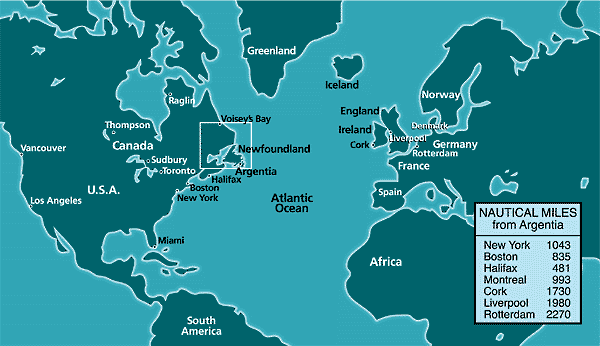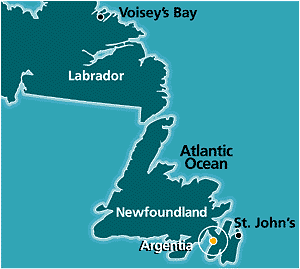| Argentia?
Isn't that a country in South America?
And why is it listed here?
First.... Argentia is a place in Newfoundland and Newfoundland is a part of Canada (now... but it wasn't in 1941). (By the way - Argentina is the S.A. country) OK. But it isn't even in America. Same
question. Why is it here?
|
|
|
|
|
| Argentia became internationally recognized
in 1941 as the site of a meeting between Sir Winston Churchill and Franklin
D. Roosevelt. They met near Ship Harbour to discuss the Atlantic Charter,
which laid the foundation for the successful outcome of WWII.
Following this historic meeting, the US Navy stayed in Argentia to construct one of the largest naval bases outside the United States. This 4,047 hectare site played a pivotal role during WWII as the operational headquarters for ships combating the enemy submarine threat. The base then played a pivotal role during the Cold War. The US Navy closed Argentia in September 1994 after 54 years of valuable service. The reason the Americans chose Argentia was simple - a deep, ice-free port, year-round access, and proximity to Europe, Canada, and the United States. But the biggest attraction was Argentia's access to the North Atlantic shipping routes. Over the years, the US Navy spent millions of dollars building, maintaining and upgrading a massive infrastructure. At its peak, there were 20,000 personnel stationed at Argentia and the base employed 5,000 Newfoundlanders. Copied from HERE |
|
|
|
|
|
|
| A joint declaration by the United States and Britain, issued during World War II, expressing certain common principles in their national policies to be followed in the postwar period. The declaration was made and signed on August 14, 1941, by President Franklin D. Roosevelt and Prime Minister Sir Winston Churchill after a series of conferences aboard a warship in the North Atlantic off the coast of Newfoundland. |
 The
two leaders declared that the U.S. and Britain sought no territorial, or
any other, aggrandizement from the war. They proclaimed the right of all
peoples to choose their own form of government and not to have boundary
changes imposed on them. The right of all nations—victors and vanquished—to
have access to the earth's natural resources was also recognized, as was
the desirability of economic cooperation among nations and improved living
conditions for working people. The charter expressed the hope that, after
the defeat of the Nazis, all countries would be able to feel secure from
aggression, and that the people of the world would be free from fear and
want. It recognized the principle of freedom of the seas, expressed the
conviction that humanity must renounce the use of force in international
relations, and affirmed the need for disarmament after the expected Allied
victory. The
two leaders declared that the U.S. and Britain sought no territorial, or
any other, aggrandizement from the war. They proclaimed the right of all
peoples to choose their own form of government and not to have boundary
changes imposed on them. The right of all nations—victors and vanquished—to
have access to the earth's natural resources was also recognized, as was
the desirability of economic cooperation among nations and improved living
conditions for working people. The charter expressed the hope that, after
the defeat of the Nazis, all countries would be able to feel secure from
aggression, and that the people of the world would be free from fear and
want. It recognized the principle of freedom of the seas, expressed the
conviction that humanity must renounce the use of force in international
relations, and affirmed the need for disarmament after the expected Allied
victory.
At a conference held in Washington, D.C., on January 1, 1942, the 26 governments then at war with the Axis powers declared that they "subscribed to a common program of purposes and principles embodied in the joint declaration...known as the Atlantic Charter." The statement embodying this adherence to the charter, called the Declaration by United Nations, was later signed by most of the free nations of the world and formed the basis of the UN organization established at San Francisco in April-June 1945 (see United Nations). |
| Article copied from HERE |
| "Atlantic Charter," Microsoft®
Encarta® Online Encyclopedia 2001 http://encarta.msn.com © 1997-2001
Microsoft Corporation. All rights reserved.
Memorial to the Atlantic Charter signing. Located at Ship Harbour, Newfoundland
|
|
|
|
|
|
|



